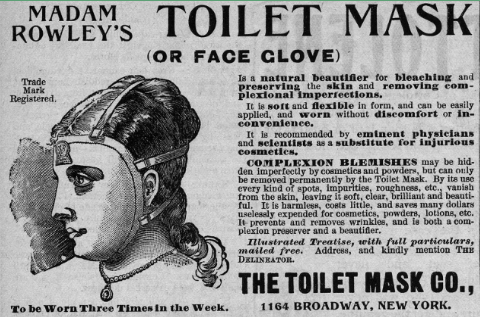From ancient Egypt to the influencer era, and beyond.
With a quick stroll through the aisles of Sephora, Nordstrom’s beauty department, or even your local drugstore, you’re guaranteed to see dozens of face mask options. Whether you use them daily as part of your skincare routine or occasionally as a self-care treat, we cannot deny that face masks are a staple in our beauty rituals.
While there’s been a rise in popularity over the last ten years, our obsession with masks is not new. We can trace it back thousands of years. Only that masks back then looked completely different from the masks sitting on your vanity today.
Technology advancements, skincare research, and our lifestyles have influenced the way we mask today. So, what did the first masks look like?
Natural origins
The OG skincare masks were made with ingredients found in nature. Masks varied depending on the region as different raw ingredients were available.
Ancient Egyptians (who were no strangers to extensive beauty routines) made their masks with clay, sometimes including honey or milk. In China, during the Tang Dynasty (618-907 AD), people used ingredients like crushed pearl, ginger root, lotus, rice water, and tea leaves to create a mask to beautify and keep a youthful complexion.
Mud-like masks like these were common in other places like India and Greece, but Korea did things differently.
Sheet masks, beef masks, and toilet masks
Ancient Korea took a different approach to masking. Instead of spreading a concoction of natural ingredients, they’d soak a gauze-like material in homemade serums to place on their face. Sounds familiar? This was the first generation of sheet masks. They have been an essential part of Korean beauty routines for centuries (and still are to this date, but more on that later).
Eventually, Europeans got their version of a sheet mask. In the Victorian Era, women would drape their faces with thin slices of raw beef or veal before bed to “fade” wrinkles. Later on, skincare innovator Madam Rowley invented a more hygienic sheet mask closer to its Korean counterpart. This was called the “Toilet Mask” or “Face Glove.”
The Toilet Mask, trademarked in 1875, was one of the first marketed masks. It was made of flexible Indian rubber that you’d fill with ointments, bleaches, and salves to treat the skin, then you’d strap it to your face. All for the sake of beauty and a porcelain-like complexion!

The 20th century – masks go mainstream
Madam Rowley’s Toilet Mask pushed the boundaries of mask innovation. But it wasn’t until mass production and the rise of mainstream beauty that face masks (and skincare) became more accessible.
It was then that we saw what we could consider the first high-tech mask — Elizabeth Arden’s Vienna Youth Mask exclusively offered in her New York Salon. Conducting cords connected the tinfoil and papier mâché mask to a diathermy machine to release a heat current that promised to stimulate circulation. All to give the skin “new youth and vigor.”
At the end of the century, at-home masking gained popularity, with companies like Avon and Mary Kay offering rinse-off solutions for different skin concerns. However, the options were still limited.
The mask boom of the 2000s
As skincare research and technology advanced, so did masks. Just in the last 15 years, we’ve seen more changes in the way we mask than in the past 100 years (fortunately, it doesn’t involve raw beef slices). The biggest contributors to the change in our masking habits were the growing interest in skin health, easily accessible information, and social media.
Suddenly, masks were no longer just a skincare treatment, they became a symbol of self-care.

People wanted to mask, not just to get results, but out of pure enjoyment. Who doesn’t love a relaxing evening with a face mask on and a good book? Brands launched a plethora of masks and introduced the concept of “multi-masking” —using more than one mask at once to address different concerns. Like shoes, people had more than one mask in their arsenal.
K-beauty made its way to the West in the 2010s. Along with the 8+ step skincare routines came the sheet masks.
The new skincare craze, along with the rise of beauty influencers, fueled the demand for masks. They earned an unexpected purpose: content.
Browsing through skincare YouTube in 2017, you could see thumbnail after thumbnail of people trying the craziest masks out there. Remember those glitter peel-off masks? Or maybe you remember the bubble face masks that would create a thick cloud-like foam over your face.
While peel-off masks became viral, other types of masks with a different mission trickled in.
The next generation of face masks
The next generation of face masks is moving beyond clickbait material and moving toward intentional design and functionality.
With a push towards sustainability, brands have experimented with packaging and formulations to offer more eco-friendly options, like reusable silicone masks and powdered masks.
Other brands are leveraging new technology to satisfy common struggles that until now had no solution. Soke Beauty is leading this sector with a line of hydrogel treatment masks designed for the most often forgotten parts of the body that show the first signs of aging (decolletage, neck, and eye contour). These hydrogel masks use a delivery system that offers visible results with 30 minutes of wear time. All without the slip or stickiness of traditional sheet masks. Soke marries the functionality of a face mask with the efficacy of eye cream—the perfect solution for people on the go who want results.

The history of face masks is rich and varied, tracing its roots thousands of years to ancient civilization. From the simple clay masks used in ancient Egypt to today’s modern hydrogel masks, face masks continue to be a must-have in our skincare routines. With new advancements in skin care and two-way conversations between brands and their customers, masks are becoming more intentional and customized to specific needs. The future of masks is sure to be exciting!
Are you ready to try the latest in masks?

